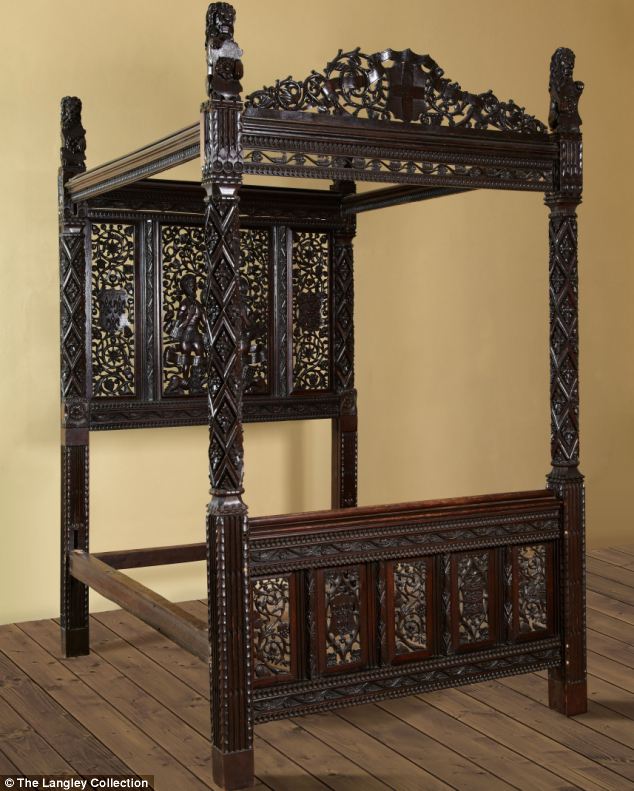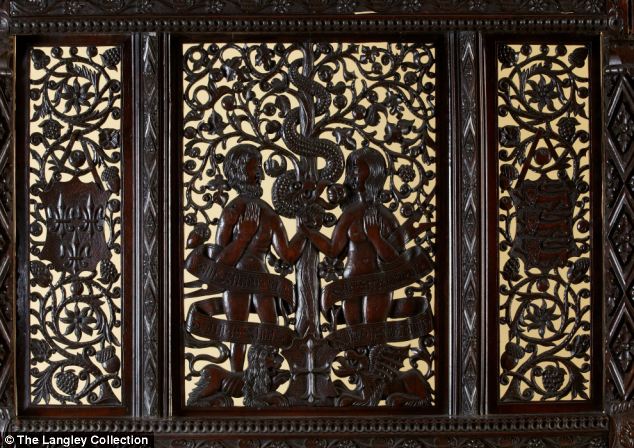
Jonathan Foyle, chief executive of World Monuments Fund Britain, has called the “Paradise Bed” the most important piece of furniture in England. The Tudor state bed was discovered by Ian Coulson, a restorer of four-poster beds, on a Chester auctioneer’s website in 2010, where it was listed as 19th-century gothic revival. Chester’s Redland Hotel was being turned into flats and the old furniture was being sold off. The bed had been collecting dust in the hotel’s attic. The bed was nearly lost, according to Coulson, as builders had dismantled it and left it in the car park rather than handing it over to the auctioneer. He purchased the bed for £2200, and now the estimate is around the £20 million mark.
In 2010, Coulson approached Foyle with a suspicion that the bed was Tudor era. Since then, Foyle has been trying to trace its’ provenance. He has traced it back to 1495, when Henry VII and Elizabeth of York went to Lathom House in Lanchashire to see the Stanley family. Henry VII’s step-father Thomas Stanley was instrumental in helping him defeat Richard III at the Battle of Bosworth in 1485, but Thomas Stanley’s brother William was executed for treason in February 1495 after supporting the pretender Perkin Warbeck.
Announcing his findings in a lecture at Crowland Abbey, Lincolnshire, on Saturday, Foyle said: “This bed belonged to Henry VII. It has to be the most important piece of furniture (in England) — and, arguably, royal artefact. Even the Westminster coronation chair has less to say than this.”
Diarmaid MacCulloch, professor of the history of the church at Oxford University, said: “This is an exceptionally important rediscovery.” If confirmed, he said, it could mean that Henry VIII was conceived in the bed.

The carved headboard is arranged as a triptych. The left panel shows the arms of France, to which English Monarchs held a residual claim, the right panel shows the arms of England, and the central panel depicts the King and Queen as Adam and Eve. Adam and Eve are shown in Paradise, making a pledge to one another, one hand over their heart and the other jointly clasped around the apple. The tree bears fruit such as grapes, apples, strawberries and acorns, widely recognised as symbols of fertility, fidelity and peace.
While Foyle has called it “the cradle of the English Reformation” the true Protestant Reformation began after the reign of Henry VIII under his son Edward VI.
The banner that wraps around the King and Queen features the inscription “The Stinge of death is Sinne: The Strength of Sinne is the Lawe” from the Tyndale and Rogers translation of the Bible printed in 1537, known as the Matthew Bible. Foyle thinks the inscription was added after 1547 during the reign of Edward VI to replace a Latin inscription.
It is thought the bed was created for the marriage of Henry VII to Elizabeth of York, on January 18, 1486. The bed lacks any example of the Tudor Rose, which was created for a progress in York in April 1486. Had the bed been created for the marriage it would have been placed in the Painted Chamber of Westminster, where the couple probably spent their wedding night. Alison Weir describes the Painted Chamber, which was destroyed by fire in 1834, as “a vast room built in the thirteenth century by Henry III, measuring eighty-six by twenty-six feet. Behind the massive four-poster bed was a mural dating from that time, showing the coronation of Edward the Confessor in faded red, blue, silver, and gold, and on the walls were huge paintings of Biblical battles. ”
It is widely thought that Prince Arthur, born just eight months after the wedding, was conceived on the wedding night, so was Prince Arthur the first Tudor Prince conceived in this bed?
A bed cover depicting Adam and Eve is mentioned in Henry VIII’s inventory of the Jewel House, which was the closest wardrobe to the painted chamber. As it depicts a similar theme the bed cover may have been used the state bed, and was left behind when the bed was removed from the Painted Chamber. Foyle thinks Henry VII and Elizabeth took the bed from Westminster to Lathom House, the original seat of the Stanley family, in the summer of 1495. It then disappears from the records until October of 1829, when George Shaw came across it in the possession of James Deardon at his house Rochdale Manor. Shaw purchased the bed from Deardon and took it to his home in Saddleworth, near Manchester. A number of derivative copies were created, and Shaw erected part of the bed above a doorway in his house as a decorative fitting. Almost two centuries later the bed turned up in Chester’s Redland Hotel.
The Paradise Bed is now on display at Auckland Castle, Bishop Auckland in County Durham, until September 30th 2014. Visit their website for more information.
More information and images at The Langley Collection



